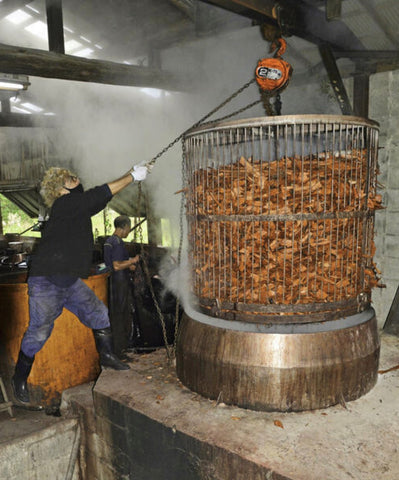
For those interested in the Ohshima Tsumugi silk making industry in present-day Japan, there was an article on Yahoo.jp news on November 28, 2021. As background, earlier this year, in our April 3, 2021 blog, we wrote in some detail about tsumugi makers,Tsumugimura -Tsumugi Village, one of the contemporary Amami Ohshima Island traditional tsumugi makers affected by this shortage of special bark used in the traditional dyeing of tsumugi silk.
The Yahoo.jp article was in Japanese only, and went into considerable detail about the challenges facing the eight remaining makers' workshops due to the closing of a supplier of this special wood.
Below is a machine translation of the Yahoo.jp article; note stilted translations in places:
There is a shortage of dark cloud dye material Sharinbai collectors at the Oshima Tsumugi manufacturing site.11/28 (Sun) 13:02 delivery11/28/21 View Japanese Language Original News Article on, Yahoo.jp HERE.: [Google Translation] There is a shortage of collectors of the dye "Sharinbai"(Yeddo Hawthorn), which is indispensable for mud dyeing of authentic Amami Oshima Tsumugi, and the people concerned are worried. In addition to the aging population, the closure of the chip factory is also having an impact. Dyeing craftsmen warn that "it is a big problem related to the survival of Oshima Tsumugi, a traditional craft of the country." Rhaphiolepis is an evergreen shrub of the genus Rhaphiolepis in the Rosaceae family. It grows naturally on rocky areas and ridges near the coast, and is also popular as a roadside tree. Mud dyeing is a dyeing method that utilizes the chemical reaction between tannic acid in plants and iron in mud fields, and Sharinbai, which contains a large amount of tannins, is used. Trees over 30 years old are used. Cut the branches, leave about 1 meter above the ground, cut them into chips, and use the liquid boiled in a kettle. It is said that 600 kg of branches can produce about 2000 liters of dyeing liquid. There are eight mud dyeing workshops in Amami Oshima, Kagoshima Prefecture, and a total of 6,000 to 7,000 kilograms of Sharinbai is consumed each month. According to the people concerned, the fact that the only chip factory in Uken Village was closed last year is also affecting the dye shortage. This is because I was able to purchase Sharinbai, which was separated from the clear-cut wood for chips. Currently, most dyeing companies ask related individuals to cut out the shortfall from the mountain. At Kanai Kogei in Toguchi, Tatsugo-cho, which uses 2400-3000 kg of Sharinbai a month, all employees hurriedly collected Sharinbai last year. Kazuto Kanai (63), a representative of the company and a traditional craftsman, said, "The color does not come out after logging, and within a few weeks in the summer. If you cut it yourself each time, the labor and cost are not worth it. I said. According to Eiki Higo (69), who is also a traditional craftsman and runs "Higo Dyeing Yumeshibori" at the door of the same town, it takes 2 to 4 days to collect 600 kg of trees when logging and transporting only Sharinbai in the mountains. It takes. The collection companies are also aging, and they say, "Now, I'm asking an acquaintance to secure it." Sharinbai has been planted as a project of prefectures and local governments. Mr. Higo pointed out that "trees can be used again in about 10 to 15 years after they have been cut down once. In the future, along with tree planting and cultivation, methods for actually using trees should be firmly established." Oshima Tsumugi is said to have a history of 1300 years, and mud dyeing is an indispensable dyeing technique when talking about the history and culture of Amami. The craftsmen are complaining that "it is not limited to the industry, but it is being questioned whether Amami can inherit mud dyeing in the future." To learn more about Amami Ohshima tsumugi-making, please visit our April 3, 2021 blog HERE. To see present offerings of older tsumugi silks on our site - both bulk kimonos and special pieces - please start HERE. |
